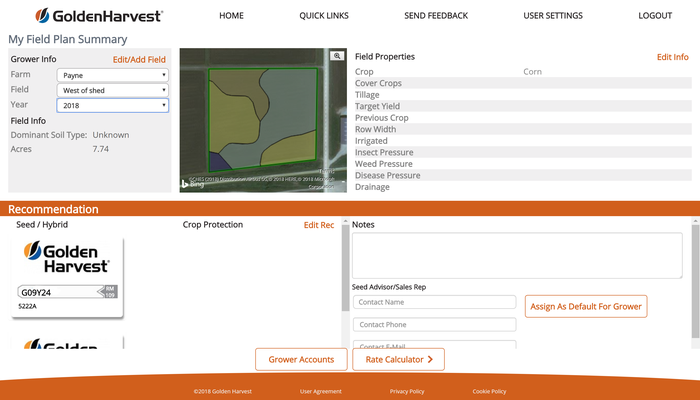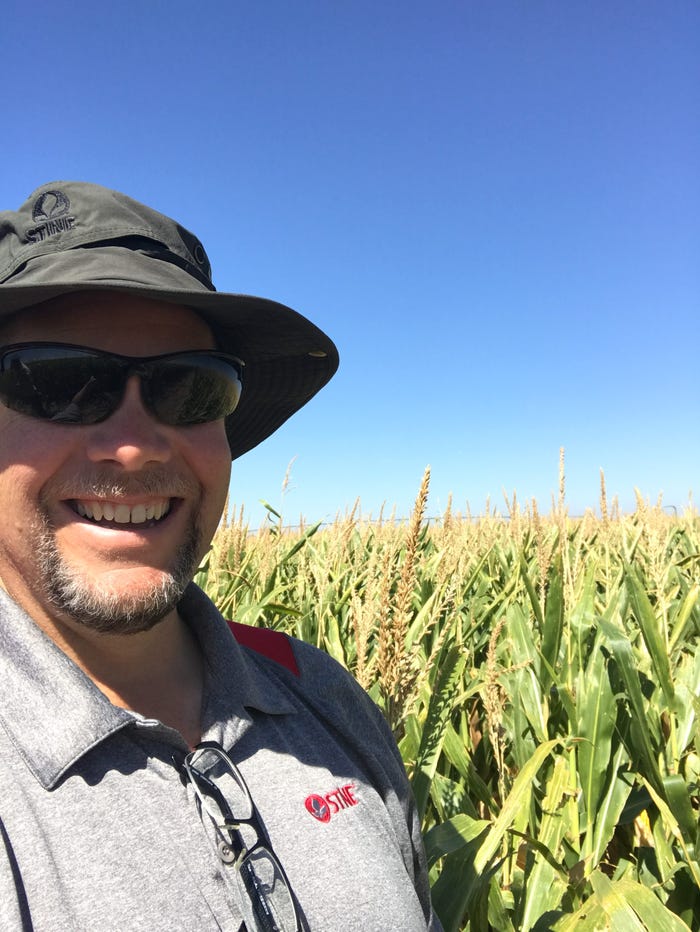August 27, 2018

-----------
Think Different
Forget finding the best hybrid—find the best data.
Seek out the right hybrid that offers optimum yield with acceptable risk.
Compare hybrid performance on similar soils and, if possible, under similar management practices and under a variety of environmental conditions.
Compare recommendations with other growers on similar soils and growing conditions, whether local or at a distance, and cross filter for the most relevant data.
-----------
As hybrids and resulting yield data maps come and go, is there a way to match these variable results to the variable soils in each field—to optimize hybrid selection and yield?
Yes, you can overlay yield and soil maps. But which hybrid with which soil type has remained the big question.
Seed company breeders are finding answers with data analytics.
"Growers fall into the trap of asking for the best hybrid," says Bruce Battles, head of agronomy, seeds, Syngenta. "However, every hybrid is a living breathing organism. Even the best athlete can't excel in every sport. The question is, what is the right hybrid. Choosing the right hybrid for a particular soil type can easily give you seven to eight bushels more yield per acre. Placing the wrong hybrid can lose seven to eight bushels the other way."
Find relevant data
Battles cites the huge database of plot trials, on-farm trials and strip trials that seed companies bring to the challenge. While sheer data is impressive, is it relevant? All too often, it may not be. He acknowledges that the seed industry (and its customers) have long relied on local data for hybrid placement. However, if the data is not defined by soil type, is it relevant? With new data analytics, recommendations are being refined.
"We have taken a step back to characterize our data against not only soil types, but how a hybrid performs in a particular soil type in a wet year versus a dry year or a cool year versus a hot year," says Battles. "We really need to look at soil type by environmental conditions and understand the stability of a hybrid on that soil type across a broader scale."
Analysis of farmer-member data by Farmers Business Network (FBN) reiterates Battles position with on-farm data. Review of 150,000,000 acre-events of data with 8,989 distinct soil types and 4,073 hybrids is the basis of soil type and texture/hybrid recommendations FBN makes to growers of corn and other crops, among its 6,700 members.

Better matches add revenue
"On many farms, we find that a five to 10% yield increase is possible by better matching varieties to soil conditions," says Megan Fallon, partner manager, FBN. "In 2017, FBN farmers who planted the corn variety that was best suited to their soil type—based on the network's data—averaged yield increases of six bushels per acre over those planting another hybrid. Yield gains jumped by 17 bushels per acre, on soils where we had data on at least 50 different hybrids."
If simply matching soil types and hybrids can boost potential yields by 17 bushels per acre, what other soil factors need to be considered? FBN's head of data science, Matt Meisner, notes that hybrid analytics were the most requested feature when the company started and is the one most frequently accessed today. It combines members' farm data with thousands of others.
"Farmers wanted data personalized to them," he says. "We give them the ability to filter data based on soil types from farms in their area, as well as those similar to them elsewhere. They can cross filter with soil texture and terrain, and to the extent we can get data, soil sampling for organic matter and fertility, as well as a wealth of additional data, such as water holding capacity, tillage, row spacing and crop rotations. They can click on a hybrid and see how it responds to fertilizer rates, seeding rates, drainage and irrigation."
What about OM and CEC?
Stine Seed is digging deep in their effort to understand the hybrid/soil connection. The company is in the second of a three-year project to better quantify the relationship using Cation Exchange Capacity (CEC) and organic matter mapping. The goal is to transcend the challenge of localized soil evaluation.
"Everyone around the country has a different way of quantifying what their soil types are," says Mike Smith, technical product agronomist, Stine Seed. "Some seed companies match their hybrids to organic matter and others to heavy, medium and light soil descriptions. We are trying to take a difficult medium and predict how genetics respond."
The Stine effort is based on the idea that CEC values are fairly universal across soil types when organic matter is used as modifier. As Smith puts it, "How much clay do you have?"
That data is folded in with how hybrids react to different populations, nutrition, water and nitrogen efficiency. Stine is attempting to build a model to understand how certain genetics respond better or worse to these factors by comparing results in retail strip trials and how they match up to the company's elite research trials.

Tillage, soil health matching
Management style is also considered. "We are trying to model behavior that affects the crop and the soil," says Smith. "We are evaluating hybrids against tillage versus no-till and in the future will likely be looking at soil health."
Smith reports that first year data was surprising, with a much greater spread when comparing different corn pedigrees in high and low CEC values. "They come together in medium textured soils, but as you get into tougher soils, it is more challenging to find the right germplasm."
While Stine is working with the company's existing and experimental germplasm in the project, Smith is confident the knowledge gained will be applicable to some extent across the industry.
"Basically, all companies are working with the same pedigrees," he says. "If we have high clay soils, is there a certain pedigree that does better?"
Genetic parity
Battles states much the same thing, "I think growers understand the marketplace has more parity in genetics than ever before," he says. "There isn't any one company that is out in front. So, if everyone is offering a good product, how do they get the most out of it?"
Relevant data is his suggestion. Golden Harvest and parent company Syngenta are making their data more available with the digital platform E-Luminate. "We are offering more transparency and access to our large data set," says Battles. "Our Golden Harvest seed advisors use E-Luminate to run data live with their customers. They define the field and its boundaries, soil types in the field and then look at historic weather data, both extremes and norms, and select a hybrid that fits their personal aversion to risk."
Battles notes that when deciding between companies, farmers are often skeptical of company data. "Our growers appreciate seeing the information on how our products perform on different soil types and under different environmental conditions. What they see resonates that resulting yield increases are real."
FBN's Fallon suggests taking the discussion off line and beyond any one company's data, and encourage sharing data. "As our membership has grown, we are hearing about more discussions within communities as growers realize their neighbors are also FBN members," she says. "The more data you have, the more insights, the more actionable and accurate the data is as well."
About the Author(s)
You May Also Like




